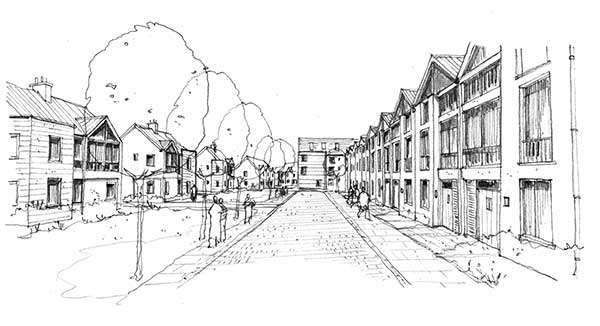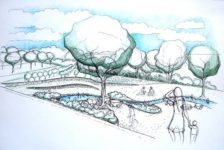So you suck at hand drawings? Your trees look like lollipops and your people seem as though they have stepped from the canvas of a van Gogh painting. Things could be worse though right? You thought so until you saw the look of confusion on your client’s face when you pulled out your life time master piece (which most likely took all night to produce). For centuries, hand drawing with a pen, pencil, or marker has served as the prized and idealized method for communicating by the design community. These works are not simply beautiful images which adorn the walls of many public and private collectors. They serve as a way to communicate form, function, scale, social issues, and more. University students around the world are entrenched deep within the debate of if designers must have excellent representation skills. They are bombarded with the ideal and the famous; not the everyday and common. This is acceptable though because schools are meant to challenge and expand students’ abilities and skill sets.
Don’t be fooled Laurie Olin, Warren Byrd, and Mike Lin are a sampling of individuals who our design community prizes for intriguing and exceptional hand graphics. But don’t be fooled. Not all designers are lauded for their drawing or sketching abilities. Certainly this is not a sign that they lack the skill, desire, or creativity. It is simply not the medium which they choose to get passionate about. Piet Odoulf and Gertrude Jekyl are some of the world’s most renowned designers, but for other reasons. You may also be interested in reading: A quick assessment of the design world will reveal that hand drawing is not the predominate form of communication in our professions. So if you suck at hand drawing or just don’t enjoy doing it take hope! There are numerous other mediums with which you can express yourself. A large amount of work is being done in visually engaging and rich ways. Adobe Photoshop and Illustrator, Autodesk and Vectorworks, Sketchup and Rhino, Kerkythea and Blender, and GIS are a small sampling of other mediums that designers create with. Many designers use montage, photography, and even models to explain their design ideas. The list is never ending. Check out our review of HDR and Digital Blending Courses It’s what you are saying not how you are saying it ‘So why are some people so caught up in hand graphics,’ you ask? It’s simple. It’s what they prefer. They can use it effectively as a tool. Instead, the debate should really be centered around ‘communication’. This is what clients are looking for when they seek the help of a design professional. Clients want a designer to ‘hear’ what they are saying and have the ability to visualize it so that it can be built. Drawing and sketching are not antiquated forms of communication. They have a pivotal role to play in design. The professional designer cannot approach her work as a child would, spending countless hours creating 3d models or photorealistic imagery. These methods take a lot of time and are not always the best tool for the job. Drawing and sketching allow designers to create numerous iterations in a short amount of time. Certainly it is one of the more powerful tools available to the designer. Hand drawing also provides an appeal to certain clients and can be just as aesthetically attractive. In ‘The Necessity for Drawing’ Michael Graves describes three types of drawing. 1. The referential sketch. 2. The preparatory sketch. 3. The definition drawing. They are not without meaning. Each one has a purpose. Vanessa Quirk of Arch Daily writes about the trap of photorealistic imagery. “It’s a trap…it’s also symptomatic of architectures obsession with the image of architecture, an image completely detached from reality…causing students to spend hours perfecting visuals instead of the design.” Digital design can be just as relevant and effective in communicating though. However, there needs to be a sense of honesty and transparency. So now that the veil has hopefully been lifted from your eyes, you no longer feel the weight to have perfect hand graphics. Whatever your form of communication be sure to do it for a reason and know how to use it effectively as a tool for exploring and communicating. Recommended Reading:- Sketching from the Imagination: An Insight into Creative Drawing by 3DTotal
- Architectural Drawing Course by Mo Zell
Article written by Cameron R. Rodman Return to Homepage
Published in Blog









